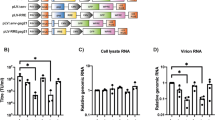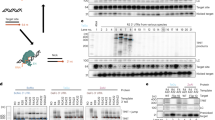Abstract
RNA interference (RNAi) has emerged as a powerful technique to downregulate gene expression. The use of polIII promoters to express small hairpin RNAs (shRNAs), combined with the versatility and robustness of lentiviral vector–mediated gene delivery to a wide range of cell types offers the possibility of long-term downregulation of specific target genes both in vitro and in vivo. The use of silencing lentivectors allows for a rapid and convenient way of establishing cell lines (or transgenic mice) that stably express shRNAs for analysis of phenotypes produced by knockdown of a gene product. Here we present two possible protocols describing the design and cloning of silencing lentiviral vectors. These protocols can be completed in less than 3 weeks.
This is a preview of subscription content, access via your institution
Access options
Subscribe to this journal
Receive 12 print issues and online access
$259.00 per year
only $21.58 per issue
Buy this article
- Purchase on Springer Link
- Instant access to full article PDF
Prices may be subject to local taxes which are calculated during checkout



Similar content being viewed by others
References
Tiscornia, G., Singer, O. and Verma, I.M. Production and purification of lentiviral vectors. Nat. Protocols (DOI: 10.1038/nprot.2006.37).
Trono, D. Lentiviral Vectors (Berlin-Heidelberg, Springer-Verlag, 2002).
Naldini, L. et al. In vivo gene delivery and stable transduction of nondividing cells by a lentiviral vector. Science 272, 263–267 (1996).
Pfeifer, A., Ikawa, M., Dayn, Y. & Verma, I.M. Transgenesis by lentiviral vectors: lack of gene silencing in mammalian embryonic stem cells and preimplantation embryos. Proc. Natl. Acad. Sci. USA 99, 2140–2145 (2002).
Lois, C., Hong, E.J., Pease, S., Brown, E.J. & Baltimore, D. Germline transmission and tissue-specific expression of transgenes delivered by lentiviral vectors. Science 295, 868–872 (2002).
Miyoshi, H., Blomer, U., Takahashi, M., Gage, F.H. & Verma, I.M. Development of a self-inactivating lentivirus vector. J. Virol. 72, 8150–8157 (1998).
Zufferey, R. et al. Self-inactivating lentivirus vector for safe and efficient in vivo gene delivery. J. Virol. 72, 9873–9880 (1998).
Denli, A.M. & Hannon, G.J. RNAi: an ever-growing puzzle. Trends Biochem. Sci. 28, 196–201 (2003).
Du, T. & Zamore, P.D. microPrimer: the biogenesis and function of microRNA. Development 132, 4645–4652 (2005).
Chen, P.Y. & Meister, G. microRNA-guided posttranscriptional gene regulation. Biol. Chem. 386, 1205–1218 (2005).
Lund, E., Guttinger, S., Calado, A., Dahlberg, J.E. & Kutay, U. Nuclear export of microRNA precursors. Science 303, 95–98 (2004).
Kim, V.N. MicroRNA precursors in motion: exportin-5 mediates their nuclear export. Trends Cell Biol. 14, 156–159 (2004).
Lee, Y. et al. The nuclear RNase III Drosha initiates microRNA processing. Nature 425, 415–419 (2003).
Fjose, A., Ellingsen, S., Wargelius, A. & Seo, H.C. RNA interference: mechanisms and applications. Biotechnol. Annu. Rev. 7, 31–57 (2001).
Hannon, G.J. RNA interference. Nature 418, 244–251 (2002).
Elbashir, S.M. et al. Duplexes of 21-nucleotide RNAs mediate RNA interference in cultured mammalian cells. Nature 411, 494–498 (2001).
Oliveira, D.M. & Goodell, M.A. Transient RNA interference in hematopoietic progenitors with functional consequences. Genesis 36, 203–208 (2003).
Brummelkamp, T.R., Bernards, R. & Agami, R. A system for stable expression of short interfering RNAs in mammalian cells. Science 296, 550–553 (2002).
Miyagishi, M. & Taira, K. U6 promoter-driven siRNAs with four uridine 3¢ overhangs efficiently suppress targeted gene expression in mammalian cells. Nat. Biotechnol. 20, 497–500 (2002).
Rubinson, D.A. et al. A lentivirus-based system to functionally silence genes in primary mammalian cells, stem cells and transgenic mice by RNA interference. Nat. Genet. 33, 401–406 (2003).
Tiscornia, G., Singer, O., Ikawa, M. & Verma, I.M. A general method for gene knockdown in mice by using lentiviral vectors expressing small interfering RNA. Proc. Natl. Acad. Sci. USA 100, 1844–1848 (2003).
Paddison, P.J., Caudy, A.A., Bernstein, E., Hannon, G.J. & Conklin, D.S. Short hairpin RNAs (shRNAs) induce sequence-specific silencing in mammalian cells. Genes Dev. 16, 948–958 (2002).
Stegmeier, F., Hu, G., Rickles, R.J., Hannon, G.J. & Elledge, S.J. A lentiviral microRNA-based system for single-copy polymerase II–regulated RNA interference in mammalian cells. Proc. Natl. Acad. Sci. USA 102, 13212–13217 (2005).
Vaucheret, H. MicroRNA-dependent trans-acting siRNA production. Sci. STKE 300, pe43 (2005).
McManus, M.T., Petersen, C.P., Haines, B.B., Chen, J. & Sharp, P.A. Gene silencing using micro-RNA designed hairpins. Rna 8, 842–850 (2002).
Dudley, N.R. & Goldstein, B. RNA interference: silencing in the cytoplasm and nucleus. Curr. Opin. Mol. Ther. 5, 113–117 (2003).
Péery, T., Mathews, M.B. & Baulcombe, D. RNA interference. Methods 30, 287–288 (2003).
Cullen, B.R. Transcription and processing of human microRNA precursors. Mol. Cell 16, 861–865 (2004).
Gregory, R.I., Chendrimada, T.P., Cooch, N. & Shiekhattar, R. Human RISC couples microRNA biogenesis and posttranscriptional gene silencing. Cell 123, 631–640 (2005).
Zeng, Y. & Cullen, B.R. Sequence requirements for micro RNA processing and function in human cells. Rna 9, 112–123 (2003).
Zeng, Y. & Cullen, B.R. Structural requirements for pre-microRNA binding and nuclear export by Exportin 5. Nucleic Acids Res. 32, 4776–4785 (2004).
Makinen, P.I. et al. Stable RNA interference: comparison of U6 and H1 promoters in endothelial cells and in mouse brain. J. Gene Med. (2006).
Myslinski, E., Ame, J.C., Krol, A. & Carbon, P. An unusually compact external promoter for RNA polymerase III transcription of the human H1RNA gene. Nucleic Acids Res. 29, 2502–2509 (2001).
Amarzguioui, M. & Prydz, H. An algorithm for selection of functional siRNA sequences. Biochem. Biophys. Res. Commun. 316, 1050–1058 (2004).
Jagla, B. et al. Sequence characteristics of functional siRNAs. Rna 11, 864–872 (2005).
Reynolds, A. et al. Rational siRNA design for RNA interference. Nat. Biotechnol. 22, 326–330 (2004).
Santoyo, J., Vaquerizas, J.M. & Dopazo, J. Highly specific and accurate selection of siRNAs for high-throughput functional assays. Bioinformatics 21, 1376–1382 (2005).
Ui-Tei, K. et al. Guidelines for the selection of highly effective siRNA sequences for mammalian and chick RNA interference. Nucleic Acids Res 32, 936–948 (2004).
Clemens, M.J. & Elia, A. The double-stranded RNA-dependent protein kinase PKR: structure and function. J. Interferon Cytokine Res. 17, 503–524 (1997).
Boden, D. et al. Promoter choice affects the potency of HIV-1-specific RNA interference. Nucleic Acids Res. 31, 5033–5038 (2003).
Brummelkamp, T.R., Bernards, R. & Agami, R. A system for stable expression of short interfering RNAs in mammalian cells. Science 296, 550–553 (2002).
Castanotto, D., Li, H. & Rossi, J.J. Functional siRNA expression from transfected PCR products. Rna 8, 1454–1460 (2002).
Acknowledgements
The authors wish to thank Kenneth Fringpong and Knut Madden of Invitrogen Corporation for their assistance in development of the L-pDest-cmv-gfp vector.
Author information
Authors and Affiliations
Corresponding author
Ethics declarations
Competing interests
The authors declare no competing financial interests.
Rights and permissions
About this article
Cite this article
Tiscornia, G., Singer, O. & Verma, I. Design and cloning of lentiviral vectors expressing small interfering RNAs. Nat Protoc 1, 234–240 (2006). https://doi.org/10.1038/nprot.2006.36
Published:
Issue Date:
DOI: https://doi.org/10.1038/nprot.2006.36
This article is cited by
-
Suppression of angiopoietin-like 4 reprograms endothelial cell metabolism and inhibits angiogenesis
Nature Communications (2023)
-
The mTOR/NF-κB Pathway Mediates Neuroinflammation and Synaptic Plasticity in Diabetic Encephalopathy
Molecular Neurobiology (2021)
-
Astrocyte Intracellular Ca2+and TrkB Signaling in the Hippocampus Could Be Involved in the Beneficial Behavioral Effects of Antidepressant Treatment
Neurotoxicity Research (2021)
-
Comparison of breast cancer metastasis models reveals a possible mechanism of tumor aggressiveness
Cell Death & Disease (2018)
-
Anti-α-synuclein immunotherapy reduces α-synuclein propagation in the axon and degeneration in a combined viral vector and transgenic model of synucleinopathy
Acta Neuropathologica Communications (2017)
Comments
By submitting a comment you agree to abide by our Terms and Community Guidelines. If you find something abusive or that does not comply with our terms or guidelines please flag it as inappropriate.



